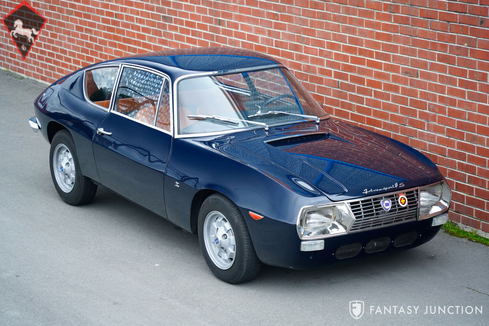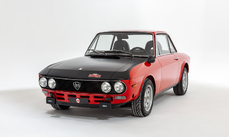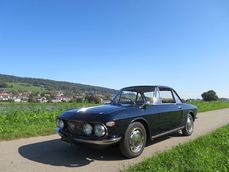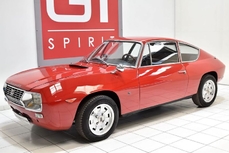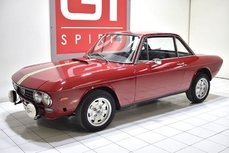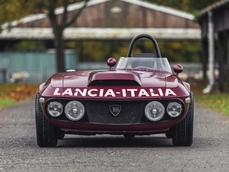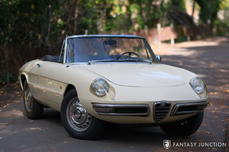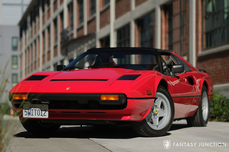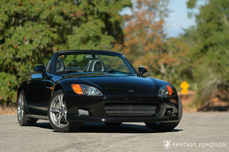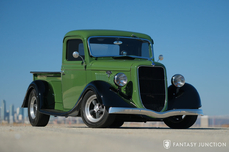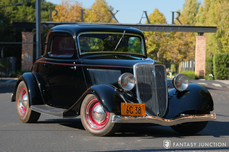Lancia Fulvia 1300cc V4 1972
General description :
1972 Lancia Fulvia 1,3S Zagato
s/n 818.650.001329, engine no. 818*303*090167*
Dark Blue with Arancia Interior
In today’s market, the phrase “Italian sports car with Zagato coachwork, disc brakes, and twin cam engine” is typically accompanied by deep six-figure price tags. Combine a legacy of innovative technical features and exquisite design and the price climbs further still. Remarkably, the Fulvia Zagato fulfills all the requirements for enjoyable vintage sports car enthusiasts, without requiring a second mortgage.
Highly regarded for their exceptional craftsmanship, innovative engineering, and cost-no-object attention to detail Lancia built some of the most elegant, refined, performance cars in their century long history. Given this philosophy, Lancia frequently found themselves making superb cars but not always following with profit. Among the last of the pre-FIAT cars, the unibody front-drive Fulvia was powered by a dual overhead cam narrow angle common-cylinder head V4 engine. Dunlop disc brakes on all four corners, light alloy component construction, and a host of additionally interesting technical features contributed to its success. Road and Track magazine described the car in 1967 as "a precision motorcar, an engineering tour de force." The Fulvia was surprisingly quick for its displacement and proved to be an effective competition car in both rally and circuit racing. The Fulvia was available in a variety of body styles including the rare and special Zagato coupe bodywork, which provided a unique profile and a surprising amount of space for larger drivers and fortunate passengers
This particular car is an early Series 2 Fulvia Sport 1.3S Zagato. Coachwork was designed and built by Zagato and fitted to the Lancia unibody platform. The Series 1 bodies featured side hinging hoods and rear drop-down spare tire compartments. During the transition from Series 1 to Series 2 cars, the first 600 of the 2600 Series 2 cars were built utilizing Series 1 bodies. This example is one of the transitional 600 Series 2 cars. During this period, the 1.3S was considered the top of the line. Imported to the US from Italy in 2004, this car resided in California from 2011-2023, including ownership with a well-known Northern California Lancia enthusiast who enjoyably used it as part of his sports car collection of Ferraris and other Lancias. The previous owner serviced the car regularly including installing new front ball joints and tie rod ends, rebuilding the generator, and generally servicing the car while making regular trips to events like the 2016 Monterey Historics, local Sacramento area European car tours, and casual car gatherings.
In 2023, the car was sold to the current owner who engaged Maranello MotorWorks, Northglenn, CO to service the car. In April 2023 a comprehensive tune-up was performed including new plugs and correct plug wires, fluids, and two radiator hoses. The rear electric window motor was replaced, new switch relays and wiring installed for more reliable operation, engine electrical wiring tested, select wiring replaced as needed, and both door panels removed to access and improve exterior door lock mechanisms. A new electric fuel pump and vibration isolators were installed along with new fuel hoses and clamps, a new heater cable installed, and a new set of seat belts were installed using structurally suitable mounting points. Further work performed by an independent specialist included replacing the front rubber leaf spring supports using parts purchased from Lancia specialists.
Today, the car presents as an attractive driver, with glossy paint and good panel fit. Close inspection reveals some bubbling at the bottom of the right front fender and the paint displays some chips, scratches, and various other imperfections, but the overall presentation is very attractive. The chrome and various trim are all in good to very good condition, particularly the hard-to-find grille and chrome plated headlight bezels. The lenses, glass, and delicate Fulvia Sport hood script announce the Italian heritage and design excellence, while Zagato badges flank both front fenders. The desirable 5.5” Cromodora wheels are in excellent shape and add a period correct performance stance to the car, giving it just the right amount of rake.
The color-contrasting interior is excellent overall. The clean black vinyl and wood dashboard are handsomely finished. The low-profile bucket seats are in excellent condition with good side bolsters and lower seat support. A small 1/8” hole is noted on the driver’s seat bottom bolster. The door panels, headliner, and wood dash trim are in very good condition. A properly housed clock and rare radio delete plate with Fulvia script finish the dashboard. The gauges and controls feature nice color and contrast, and excellent trim. The correct ribbed and fitted rubber floor mats are similarly nice as is the leather wrapped Lancia steering wheel. Lifting the rear hatch, the rear storage area is finished and trimmed with appropriate materials. Further, the rear hatch can be electronically raised and lowered from a dash switch, allowing cabin ventilation, a quintessentially Lancia feature that is both functional and clever.
The engine compartment is honest and tidy, with generally correct finishes, original components, and properly sorted hardware. The engine is a correct type 303 1.3 series engine, although it is a later serial number than is generally associated with early S2 cars. The engine compartment appears largely original with correct presentation and good detailing. The engine is fitted with a correct set of Solex carburetors with an original air cleaner housing.
The car runs and drives well, starting easily and revving freely. The dogleg 5-speed gearbox has good synchromesh and moves smoothly through all gears. The chassis has a coherent and comfortable feel, perfectly suited for mountain roads and spirited driving. The Fulvia is known for light and communicative steering, delivering precise and responsive results – certainly one of the top characteristics of this model.
This is an excellent opportunity to acquire a rare, technically interesting, and entertaining classic Lancia Fulvia Sport with unique Zagato coachwork. Rarely found in the United States, the Fulvia Sport benefits from robust North American parts sources and excellent club support. This twin-cam, coachbuilt, Italian sports car is ready for the next chapter in enthusiast enjoyment – one that is sure to delight onlookers with the rarity, performance, and unique design befitting the premier Lancia legacy. Included with the sale is a correct Fulvia tool kit.
1972 Lancia Fulvia 1300cc V4 is listed for sale on ClassicDigest in California by Fantasy Junction for $39500.
Car Facts
Car type : Car Make : Lancia Model : Fulvia Model Version : 1300cc V4 Engine size : 1.3 Model Year : 1972 Location : Emeryville Vehicle Registration : Normal
39500 $
Seller Information
Fantasy Junction
Fantasy Junction
+1 510 653 7555
Fantasy Junction
+1 510 653 7555
People who viewed this Lancia Fulvia also viewed similar Lancia listed at ClassicDigest
Other cars listed for sale by this dealer
About Lancia
Ah, Lancia, the Italian marque that danced on the edge of automotive brilliance! Let me take you on a journey through the captivating story of Lancia, a brand that embodies passion, innovation, and rallying prowess.Act 1: The Early Years (1906-1920s)
Lancia was founded in 1906 by Vincenzo Lancia, an engineering wizard with a flair for the extraordinary. The brand quickly gained a reputation for its precision engineering and innovative approach. The Lancia Alpha, introduced in 1907, was the first car to feature a narrow-angle V4 engine, setting the tone for Lancia's commitment to technical excellence.
Act 2: Innovation at its Core (1930s-1950s)
The 1930s saw Lancia pushing the boundaries of innovation with models like the Lambda, the first car to feature a load-bearing monocoque chassis. The Aprilia, introduced in the 1930s, showcased cutting-edge aerodynamics and a V4 engine, solidifying Lancia's reputation as a pioneer.
Act 3: Post-War Elegance (1950s-1960s)
After World War II, Lancia continued to dazzle with models like the Aurelia, the first production car to feature a V6 engine. It blended performance with comfort and elegance. The Flaminia followed, embodying luxury and advanced engineering.
Act 4: Rally Domination (1970s-1980s)
Lancia etched its name in motorsport history with an unparalleled rally legacy. The Lancia Stratos, a wedge-shaped wonder, dominated the rally scene in the 1970s, clinching three consecutive World Rally Championships from 1974 to 1976. The Delta Integrale, introduced in the 1980s, continued this rally reign with multiple championships.
Act 5: Struggles and Resilience (1990s-2000s)
The latter part of the 20th century brought financial challenges for Lancia, leading to collaborations with other automakers. Despite the difficulties, Lancia introduced models like the Thesis and the Ypsilon, showcasing its commitment to style and substance.
Act 6: 21st Century Reinvention (2010s-Present)
In the 2010s, Lancia faced a shift in strategy, focusing on the Ypsilon as its primary model. While production numbers dwindled, the brand maintained its reputation for distinctive design and comfort.
Epilogue: A Legacy of Passion and Innovation
Lancia's story is one of passion, innovation, and motorsport glory. The brand, with its groundbreaking designs, technological advancements, and rallying triumphs, has left an indelible mark on the automotive world. Lancia may have faced challenges in recent years, but its legacy lives on, celebrated by enthusiasts who recognize the magic woven into each Lancia creation. Finally, Here are some of the most important Lancia models that have left an enduring mark:
1. Lancia Lambda (1922-1931):
The Lancia Lambda is often considered a pioneering model, being the first car to feature a load-bearing monocoque chassis. This innovation set the stage for modern automotive design. The Lambda was available in various body styles and showcased Lancia's commitment to engineering excellence.
2. Lancia Aurelia (1950-1958):
The Aurelia, introduced in the early 1950s, was a groundbreaking model for Lancia. It was the first production car to feature a V6 engine, and it incorporated advanced engineering, including a rear transaxle and inboard rear brakes. The Aurelia set new standards for performance and comfort.
3. Lancia Flaminia (1957-1970):
Continuing Lancia's tradition of combining style with innovation, the Flaminia was introduced as a luxury sedan. It featured a V6 engine, a de Dion rear suspension, and avant-garde styling. The Flaminia further solidified Lancia's reputation for producing high-end, technically advanced vehicles.
4. Lancia Stratos (1973-1978):
The Lancia Stratos is an icon in the world of rallying. Born out of Lancia's rallying ambitions, the Stratos was purpose-built for competition. With its distinctive wedge-shaped design and a mid-mounted V6 engine, it became the first car to win the World Rally Championship three times consecutively from 1974 to 1976.
5. Lancia Delta (1979-1994):
The Lancia Delta is synonymous with rally success. It dominated the rally scene in the late '80s and early '90s, winning six consecutive manufacturers' titles in the World Rally Championship. The Delta's combination of performance, agility, and versatility made it an icon both on and off the rally stages.
6. Lancia Thema 8.32 (1986-1994):
The Lancia Thema 8.32 was a performance-oriented version of the Thema sedan, and it stood out for its collaboration with Ferrari. It featured a 3.0-liter V8 engine sourced from Ferrari, making it one of the few sedans with a Ferrari powerplant. This model showcased Lancia's ability to blend luxury and performance.
